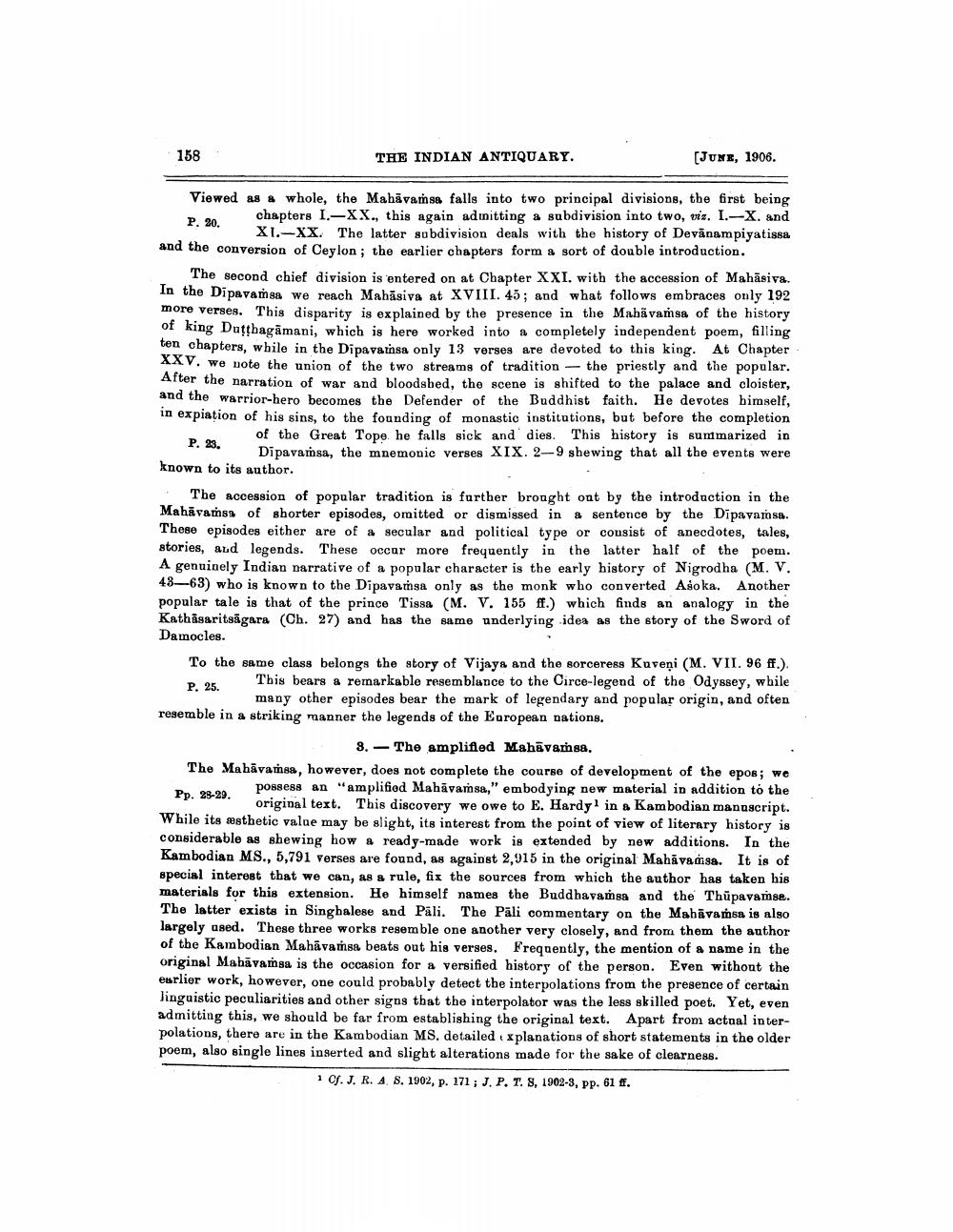________________
158
.
THE INDIAN ANTIQUARY.
(JUNE, 1906.
Viewed as a whole, the Mahāvamsa falls into two principal divisions, the first being P. 20.
chapters I.--XX., this again adtnitting a subdivision into two, us. I.-X. and
XI.-XX. The latter subdivision deals with the history of Devānampiyatissa and the conversion of Ceylon; the earlier chapters form a sort of double introduction.
The second chief division is entered on at Chapter XXI. with the accession of Mahāsiva. In the Dipavasa we reach Mahāsiva at XVIII. 45; and what follows embraces only 192 more verses. This disparity is explained by the presence in the Mahavamsa of the history of king Dutthagamani, which is here worked into a completely independent poem, filling ten chapters, while in the Dipavarsa only 13 verses are devoted to this king. At Chapter AAV. we note the union of the two streams of tradition - the priestly and the popular. After the narration of war and bloodsbed, the scene is shifted to the palace and cloister, and the warrior-hero becomes the Defender of the Buddhist faith. He devotes himself, in expiation of his sins, to the founding of monastic institutions, but before the completion
of the Great Tope. he falls sick and dies. This history is summarized in P. 23.
Dīpavamsa, the mnemonic verses XIX. 2-9 shewing that all the events were known to its author.
The accession of popular tradition is further brought out by the introduction in the Mahāvams of shorter episodes, omitted or dismissed in a sentence by the Dipavarosa. These episodes either are of a secular and political type or cousist of anecdotes, tales, stories, and legends. These occar more frequently in the latter half of the poem. A genuinely Indian narrative of a popular character is the early history of Nigrodha (M. V. 43-63) who is known to the Dipavatnga only as the monk who converted Asoka. Another popular tale is that of the prince Tissa (M. V. 155 ff.) which finds an analogy in the Kathāgaritsāgara (Ch. 27) and has the same underlying idea as the story of the Sword of Damocles.
To the same class belongs the story of Vijaya and the sorceress Kureņi (M. VII. 96 ff.). P. 25. 25 This bears a remarkable resemblance to the Circe-legend of the Odyssey, while
many other episodes bear the mark of legendary and popular origin, and often resemble in a striking manner the legends of the European nations.
8.- The amplified Mahāvamsa. The Mahāvamsa, however, does not complete the course of development of the epos; we
S possess an "amplifiod Mahavamsa," embodying new material in addition to the
• original text. This discovery we owe to E. Hardy in a Kambodian manuscript. While its wsthetic value may be slight, its interest from the point of view of literary history is considerable as shewing how a ready-made work is extended by new additions. In the Kambodian MS., 5,791 verses are found, as against 2,915 in the original Mahāvadsa. It is of special interest that we can, as a rule, fix the sources from which the author has taken his materials for this extension. He himself names the Buddhavamsa and the Thüpavamse. The latter exists in Singhalese and Pāli. The Pali commentary on the Mahāvamsa is also largely used. These three works resemble one another very closely, and from them the author of the Kambodian Mahavamsa beats out his verses. Frequently, the mention of a name in the original Mahāvamsa is the occasion for a versified history of the person. Even without the earlier work, however, one could probably detect the interpolations from the presence of certain linguistic peculiarities and other signs that the interpolator was the less skilled poet. Yet, even admitting this, we should be far from establishing the original text. Apart from actual interpolations, there are in the Kambodian MS. detailed explanations of short statements in the older poem, also single lines inserted and slight alterations made for the sake of clearness.
1 Cf. J. R. A. 8. 1902, p. 171; J. P. T. 9, 1902-3, pp. 61 ff.




